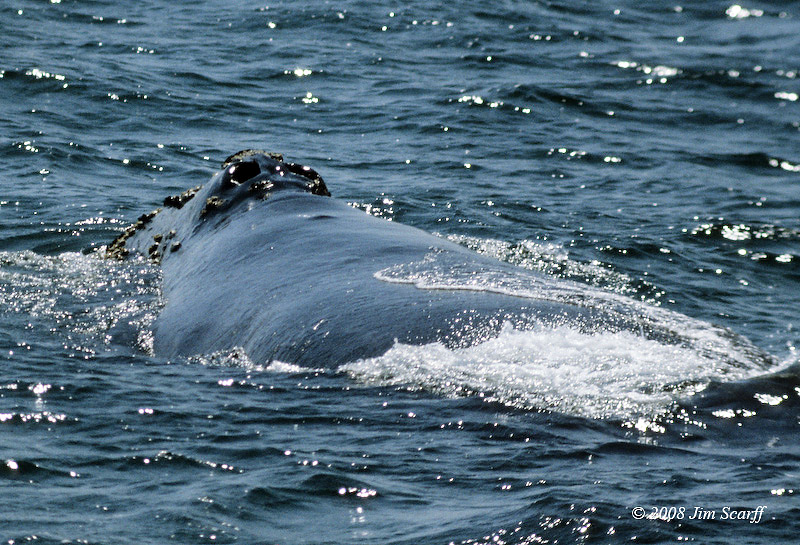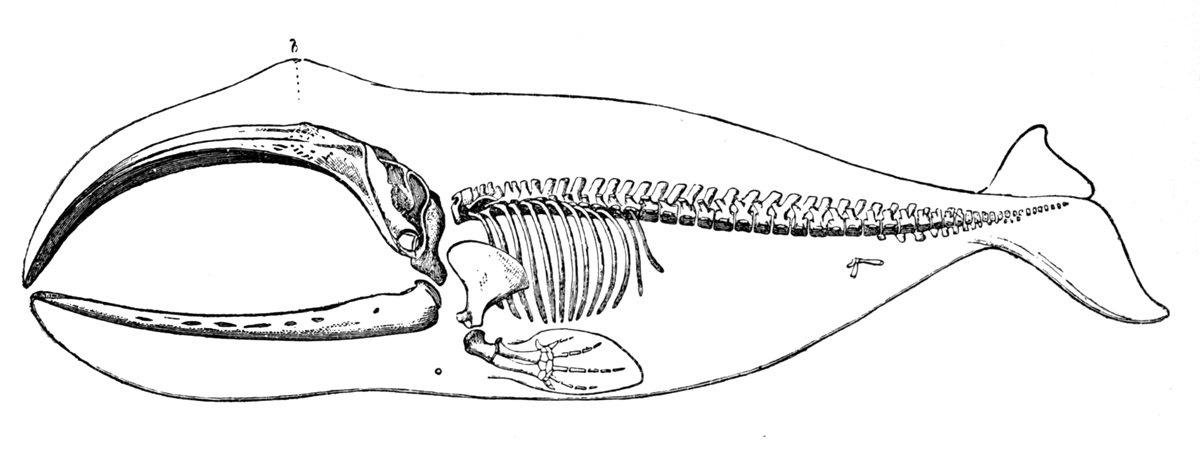|
Right Whale
Right whales are three species of large baleen whales of the genus ''Eubalaena'': the North Atlantic right whale (''E. glacialis''), the North Pacific right whale (''E. japonica'') and the southern right whale (''E. australis''). They are classified in the family Balaenidae with the bowhead whale. Right whales have rotund bodies with arching rostrum (anatomy), rostrums, V-shaped blowhole (anatomy), blowholes and dark gray or black skin. The most distinguishing feature of a right whale is the rough patches of skin on its head, which appear white due to parasitism by whale lice. Right whales are typically long and weigh up to or more. All three species are Animal migration, migratory, moving seasonally to feed or give birth. The warm equatorial waters form a barrier that isolates the northern and southern species from one another although the southern species, at least, has been known to cross the equator. In the Northern Hemisphere, right whales tend to avoid open waters and st ... [...More Info...] [...Related Items...] OR: [Wikipedia] [Google] [Baidu] |
North Atlantic Right Whale
The North Atlantic right whale (''Eubalaena glacialis'') is a baleen whale, one of three right whale species belonging to the genus ''Eubalaena'', all of which were formerly classified as a single species. Because of their docile nature, their slow surface-skimming feeding behaviors, their tendencies to stay close to the coast, and their high blubber content (which makes them float when they are killed, and which produces high yields of whale oil), right whales were once a preferred target for whalers. At present, they are among the most endangered whales in the world, and they are protected under the U.S. Endangered Species Act and Marine Mammal Protection Act of 1972, Marine Mammal Protection Act and Canada's Species at Risk Act. There are an estimated 356 individuals in existence in the western North Atlantic Ocean—they migrate between feeding grounds in the Labrador Sea and their winter calving areas off Georgia (U.S. state), Georgia and Florida, an ocean area with heavy ship ... [...More Info...] [...Related Items...] OR: [Wikipedia] [Google] [Baidu] |
North Pacific Right Whale
The North Pacific right whale (''Eubalaena japonica'') is a very large, thickset baleen whale species that is extremely rare and endangered. The Northeast Pacific population, which summers in the southeastern Bering Sea and Gulf of Alaska, may have no more than 40 animals. A western population that summers near the Commander Islands, the coast of Kamchatka, along the Kuril Islands and in the Sea of Okhotsk is thought to number in the low hundreds. Before commercial whaling in the North Pacific (i.e. pre-1835) there were probably over 20,000 right whales in the region. The taking of right whales in commercial whaling has been prohibited by one or more international treaties since 1935. Nevertheless, between 1962 and 1968, illegal Soviet whaling killed at least 529 right whales in the Bering Sea and the Gulf of Alaska as well as at least 132 right whales in the Sea of Okhotsk, plus an additional 104 North Pacific right whales from unspecified areas. The International Union for Con ... [...More Info...] [...Related Items...] OR: [Wikipedia] [Google] [Baidu] |
Southern Right Whale
The southern right whale (''Eubalaena australis'') is a baleen whale, one of three species classified as right whales belonging to the genus ''Eubalaena''. Southern right whales inhabit oceans south of the Equator, between the latitudes of 20° and 60° south. In 2009 the global population was estimated to be approximately 13,600. Taxonomy Right whales were first classified in the genus '' Balaena'' in 1758 by Carl Linnaeus, who at the time considered all right whales (including the bowhead) to be a single species. In the 19th and 20th centuries the family Balaenidae was the subject of great taxonometric debate. Authorities have repeatedly recategorised the three populations of right whale plus the bowhead whale, as one, two, three or four species, either in a single genus or in two separate genera. In the early whaling days, they were all thought to be a single species, ''Balaena mysticetus''. The southern right whale was initially described as ''Balaena australis'' by Des ... [...More Info...] [...Related Items...] OR: [Wikipedia] [Google] [Baidu] |
Eubalaena Ianitrix
Right whales are three species of large baleen whales of the genus ''Eubalaena'': the North Atlantic right whale (''E. glacialis''), the North Pacific right whale (''E. japonica'') and the southern right whale (''E. australis''). They are classified in the family Balaenidae with the bowhead whale. Right whales have rotund bodies with arching rostrums, V-shaped blowholes and dark gray or black skin. The most distinguishing feature of a right whale is the rough patches of skin on its head, which appear white due to parasitism by whale lice. Right whales are typically long and weigh up to or more. All three species are migratory, moving seasonally to feed or give birth. The warm equatorial waters form a barrier that isolates the northern and southern species from one another although the southern species, at least, has been known to cross the equator. In the Northern Hemisphere, right whales tend to avoid open waters and stay close to peninsulas and bays and on continental she ... [...More Info...] [...Related Items...] OR: [Wikipedia] [Google] [Baidu] |
Bowhead Whale
The bowhead whale (''Balaena mysticetus''), sometimes called the Greenland right whale, Arctic whale, and polar whale, is a species of baleen whale belonging to the family Balaenidae and is the only living representative of the genus '' Balaena''. It is the only baleen whale endemic to the Arctic and subarctic waters, and is named after its characteristic massive triangular skull, which it uses to break through Arctic ice. Bowheads have the largest mouth of any animal representing almost one-third of the length of the body, the longest baleen plates with a maximum length of , and may be the longest-lived mammals, with the ability to reach an age of more than 200 years. The bowhead was an early whaling target. Their population was severely reduced before a 1966 moratorium was passed to protect the species. Of the five stocks of bowhead populations, three are listed as "endangered", one as " vulnerable", and one as "lower risk, conservation dependent" according to the IUCN Red ... [...More Info...] [...Related Items...] OR: [Wikipedia] [Google] [Baidu] |
John Edward Gray
John Edward Gray (12 February 1800 – 7 March 1875) was a British zoologist. He was the elder brother of zoologist George Robert Gray and son of the pharmacologist and botanist Samuel Frederick Gray (1766–1828). The same is used for a zoological name. Gray was keeper of zoology at the British Museum in London from 1840 until Christmas 1874, before the natural history holdings were split off to the Natural History Museum. He published several catalogues of the museum collections that included comprehensive discussions of animal groups and descriptions of new species. He improved the zoological collections to make them amongst the best in the world. Biography Gray was born in Walsall, but his family soon moved to London, where Gray studied medicine. He assisted his father in writing ''The Natural Arrangement of British Plants'' (1821). After being blackballed by the Linnean Society of London, Gray shifted his interest from botany to zoology. He began his zoological ... [...More Info...] [...Related Items...] OR: [Wikipedia] [Google] [Baidu] |
Sperm Competition
Sperm competition is the competitive process between Spermatozoon, spermatozoa of two or more different males to fertility, fertilize the same Egg cell, egg during sexual reproduction. Competition can occur when females have multiple potential mating partners. Greater choice and variety of mates increases a female's chance to produce more viable offspring. However, multiple mates for a female means each individual male has decreased chances of producing offspring. Sperm competition is an evolutionary pressure on males, and has led to the development of adaptations to increase male's chance of reproductive success. Sperm competition results in a sexual conflict between males and females. Males have evolved several defensive tactics including: mate-guarding, mating plugs, and releasing toxic seminal substances to reduce female re-mating tendencies to cope with sperm competition. Offensive tactics of sperm competition involve direct interference by one male on the reproductive succes ... [...More Info...] [...Related Items...] OR: [Wikipedia] [Google] [Baidu] |
Gestation
Gestation is the period of development during the carrying of an embryo, and later fetus, inside viviparous animals (the embryo develops within the parent). It is typical for mammals, but also occurs for some non-mammals. Mammals during pregnancy can have one or more gestations at the same time, for example in a multiple birth. The time interval of a gestation is called the '' gestation period''. In obstetrics, '' gestational age'' refers to the time since the onset of the last menses, which on average is fertilization age plus two weeks. Mammals In mammals, pregnancy begins when a zygote (fertilized ovum) implants in the female's uterus and ends once the fetus leaves the uterus during labor or an abortion (whether induced or spontaneous). Humans In humans, pregnancy can be defined clinically, biochemically or biologically. Clinically, pregnancy starts from first day of the mother's last period. Biochemically, pregnancy starts when a woman's human chorionic gonado ... [...More Info...] [...Related Items...] OR: [Wikipedia] [Google] [Baidu] |






